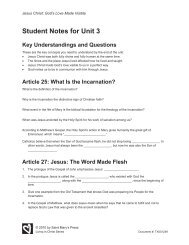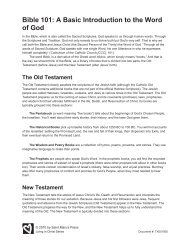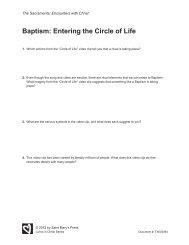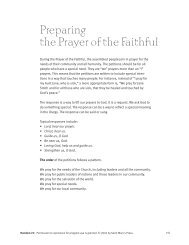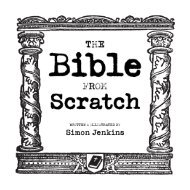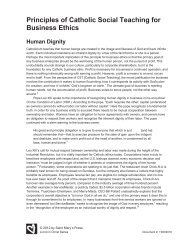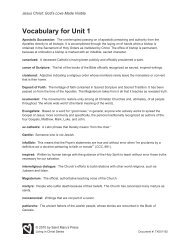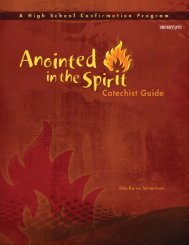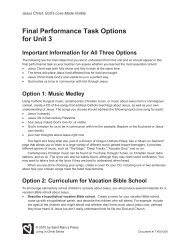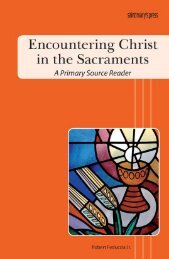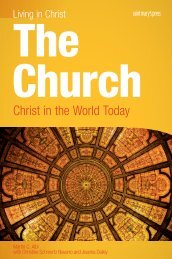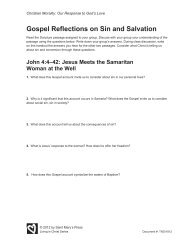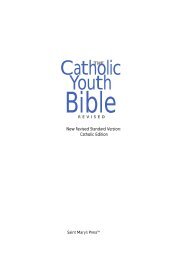What Is the Bible? - Saint Mary's Press
What Is the Bible? - Saint Mary's Press
What Is the Bible? - Saint Mary's Press
You also want an ePaper? Increase the reach of your titles
YUMPU automatically turns print PDFs into web optimized ePapers that Google loves.
Photo (top facing page): This is one of <strong>the</strong> caves near Qumran where <strong>the</strong> Dead Sea Scrolls were discovered. The Dead Sea Scrolls are saidto be <strong>the</strong> greatest modern discovery for <strong>Bible</strong> scholars.<strong>What</strong> <strong>Is</strong> <strong>the</strong> <strong>Bible</strong>?The <strong>Bible</strong> is a library of books that is divided into two parts: <strong>the</strong> Old Testament(before Jesus) and <strong>the</strong> New Testament (after Jesus’s birth). Each part consists of acollection of books that are grouped into <strong>the</strong>se sections:› The Pentateuch (fi ve books) tells about God’s Chosen People, <strong>the</strong><strong>Is</strong>raelites. You’ll read about <strong>the</strong>ir early stories, <strong>the</strong>ir history, and <strong>the</strong> lawsGod gave <strong>the</strong>m.› The Historical Books pick up <strong>Is</strong>raelite history from 1250 BC to100 BC. You will fi nd accounts of <strong>the</strong> <strong>Is</strong>raelites’ settling <strong>the</strong> PromisedLand, <strong>the</strong> rise and fall of <strong>the</strong>ir kings, <strong>the</strong>ir dispersion into exile, and <strong>the</strong>ireventual return to <strong>the</strong> Promised Land.› The Wisdom and Poetry Books are a collection of hymns, poems,proverbs, and stories. They use imaginative language to make <strong>the</strong>irpoints.GenesisExodusLeviticusNumbersDeuteronomyEzraNehemiahTobitJudithEs<strong>the</strong>r1 Maccabees2 Maccabees<strong>Is</strong>aiahJeremiahLamentationsBaruchEzekielDanielMat<strong>the</strong>wMarkLukeJohnActs of <strong>the</strong> ApostlesGospels and Acts1 Timothy*2 Timothy*Titus*PhilemonHebrews*Pauline LettersJoshuaJudgesRuth1 Samuel2 Samuel1 Kings2 Kings1 Chronicles2 ChroniclesJobPsalmsProverbsEcclesiastesHoseaJoelAmosObadiahJonahMicahNahumHabakkukZephaniahHaggaiZechariahMalachiPauline LettersSong of SolomonWisdom of SolomonSirach*These letters may have been written by a later disciple writing in Paul’s name.› The Prophets are people who speak God’s word. In <strong>the</strong>se books, youwill fi nd comfort and promise, and will be challenged to act with justiceand mercy.› The Gospels and <strong>the</strong> Acts of <strong>the</strong> Apostles. The Gospels (GoodNews) focus on <strong>the</strong> person and teachings of Jesus. The Acts of <strong>the</strong>Apostles shows how <strong>the</strong> Church was formed and how <strong>the</strong> fi rst Christiansspread <strong>the</strong> Good News. These books cover 5 BC to <strong>the</strong> early AD60’s.› The Letters and Revelation. The Letters, or Epistles (written by Paul,his followers, and o<strong>the</strong>r disciples), are actual letters that describe <strong>the</strong>new Christian faith, give advice, and offer words of hope. Revelation isa collection of mystical visions written to encourage <strong>the</strong> early Christianswho were being persecuted.How Can I Find Things in <strong>the</strong> <strong>Bible</strong>?Each book of <strong>the</strong> <strong>Bible</strong> is divided into chapters; each chapter is dividedinto verses.To locate John 3:16–17, fi rst look for <strong>the</strong>Gospel of John (using <strong>the</strong> table of contents),<strong>the</strong>n look for <strong>the</strong> third chapter (<strong>the</strong> largenumbers), and <strong>the</strong> sixteenth to seventeenthverses (<strong>the</strong> small numbers) in that chapter.How Did We Get <strong>the</strong> <strong>Bible</strong>?It would be nice to imagine that God gave us <strong>the</strong> <strong>Bible</strong> in one neatly boundbook, but <strong>the</strong> actual process was more complicated than that! Scholarscall <strong>the</strong> result <strong>the</strong> canon—<strong>the</strong> offi cial list of sacred books.The Development of <strong>the</strong> Old TestamentAt fi rst, stories about <strong>Is</strong>rael’s history were passed on from generation togeneration by word of mouth. Around 1200 BC, people started writingdown <strong>the</strong>se stories. The stories, along with laws and poetry, were graduallycombined and edited, and <strong>the</strong> “books,” as we know <strong>the</strong>m, began to takeshape in <strong>the</strong> sixth century BC. Most of <strong>the</strong> Old Testament was writtenin Hebrew, but by <strong>the</strong> fourth century BC, Greek had become <strong>the</strong> mostinfl uential language and many Jews could speak nothing else. During<strong>the</strong> third and second centuries BC, a Greek translation of <strong>the</strong> HebrewScriptures (<strong>the</strong> Septuagint) began to take shape. It has more booksin it than <strong>the</strong> present Hebrew canon, which was established in <strong>the</strong> fi rstcentury AD. These books (called deuterocanonical) include Tobit, Judith,1 and 2 Maccabees, Wisdom, Sirach, Baruch, and additions to<strong>the</strong> books of Es<strong>the</strong>r and Daniel. Most Protestant bibles do not include<strong>the</strong>se books, which Protestants call <strong>the</strong> apocrypha. Many Protestants,however, still consider <strong>the</strong>m spiritually useful.Copyrighted MaterialRomans1 Corinthians2 CorinthiansGalatiansEphesians*PhilippiansColossians*1 Thessalonian2 Thessalonians*James1 Peter2 Peter1 John2 John3 JohnJudeRevelationThe Development of <strong>the</strong> New TestamentThe language Jesus spoke was Aramaic, but <strong>the</strong> New Testament waswritten in Greek. The oldest books in <strong>the</strong> New Testament are <strong>the</strong> lettersof Paul; 1 Thessalonians probably was Paul’s earliest letter (c. AD51). Stories about Jesus and his teachings, passed down orally at fi rst,were eventually written down. The earliest collection of <strong>the</strong>se writings isMark’s Gospel (c. AD 70). (Gospel, evangelion in Greek, means “goodnews.”) The last book written in <strong>the</strong> New Testament was probably 2Peter (c. AD 130). In AD 367, in response to a debate that arose aboutwhich of <strong>the</strong> many new Christian books should be considered sacred,Athanasius suggested a list that comprises <strong>the</strong> New Testament today.Later councils, in <strong>the</strong> fourth and fi fth centuries AD, affi rmed this list andclosed <strong>the</strong> canon.Under <strong>the</strong> Guidance of <strong>the</strong> SpiritSo, did a bunch of old guys just decide on <strong>the</strong>ir own what would go into<strong>the</strong> Old and New Testaments? No! The Holy Spirit guided <strong>the</strong> processfrom oration to composition to editing to canonization. The stories thatsurvived are <strong>the</strong> ones in which God’s people heard God speaking. Intime <strong>the</strong> Spirit inspired God’s people to write down <strong>the</strong>se stories andedit <strong>the</strong>m to illustrate <strong>the</strong>ir growing understanding of God’s plan of salvation.Finally, <strong>the</strong> leaders who selected and closed <strong>the</strong> two canonsmade <strong>the</strong>ir decisions based on what was already happening through<strong>the</strong> Spirit within God’s people.How Did We Get <strong>the</strong> CatholicTranslation of <strong>the</strong> <strong>Bible</strong>?In AD 382 Pope Damasus asked Jerome to offer a standardized Latintranslation of <strong>the</strong> <strong>Bible</strong>. Working from <strong>the</strong> Hebrew and Greek, Jeromeproduced <strong>the</strong> Vulgate (editio vulgata, meaning “common version”),which became <strong>the</strong> authoritative biblical text for Catholics for centuries. In1943 Pope Pius XII allowed scholars to use <strong>the</strong> Hebrew and Greek forsubsequent translations. Noteworthy Catholic translations are <strong>the</strong> NewAmerican <strong>Bible</strong> (NAB); <strong>the</strong> New Jerusalem <strong>Bible</strong> (NJB); <strong>the</strong> Good NewsTranslation, Catholic Edition (GNT); and <strong>the</strong> New Revised Standard Version,Catholic Edition (NRSV).<strong>What</strong> Are Some Common MythsAbout <strong>the</strong> <strong>Bible</strong>?Myth 1: The <strong>Bible</strong> provides all <strong>the</strong> answers to life’squestions.Fact: Some people wish <strong>the</strong> <strong>Bible</strong> were <strong>the</strong> answer book for our faith,but <strong>the</strong> <strong>Bible</strong> doesn’t tell us what to do in every situation in life. Insteadof preaching on hundreds of rules, Jesus focused on one law—to loveGod and o<strong>the</strong>rs—as a way to live. In addition to <strong>the</strong> <strong>Bible</strong>, CatholicChristians believe that God also has given us <strong>the</strong> sacred Tradition of <strong>the</strong>Church to help us with life’s questions.Myth 2: We know who wrote each book of <strong>the</strong> <strong>Bible</strong>.Fact: The real author of a book in <strong>the</strong> <strong>Bible</strong> isn’t necessarily <strong>the</strong> nameassociated with it. For instance, both <strong>the</strong> Letter to <strong>the</strong> Romans and <strong>the</strong>Letter to <strong>the</strong> Ephesians say that Paul is <strong>the</strong> author of those letters. Paulwas certainly <strong>the</strong> author of Romans (Pauline letter), but probably notof Ephesians (Deutero-Pauline letter). A common practice in biblicaltimes was to write using <strong>the</strong> name of a famous person. Today we mayconsider this fraud, but at that time it was a way to say, “I’m a followerand admirer of a certain famous person.” This practice is called pseudonymouswriting.Myth 3: The events in <strong>the</strong> <strong>Bible</strong> happened in <strong>the</strong>order that <strong>the</strong>y appear.Fact: People often start reading <strong>the</strong> <strong>Bible</strong>, beginning with Genesis, andexpect to fi nd a seamless timeline of biblical history. Even though <strong>the</strong>books of Genesis through 2 Kings appear to be laid out chronologically,<strong>the</strong> story line is actually interrupted with stories that are repeated (seeGen 1:1—2:3 and 2:4–25) and with genealogies and laws that oftenprove discouraging to <strong>the</strong> reader. Then <strong>the</strong> next set of books, 1 and 2Chronicles, begin by telling some stories all over again. This sometimesconfusing order occurs because <strong>the</strong>re were so many authors and <strong>the</strong>ysometimes had different versions of <strong>the</strong> same stories; even within asingle book like Genesis, <strong>the</strong>re are several sources. When <strong>the</strong> storieswere eventually collected and edited, <strong>the</strong>y were put side by side in <strong>the</strong>order we now have in <strong>the</strong> <strong>Bible</strong>.Myth 4: The <strong>Bible</strong> predicts <strong>the</strong> future and tells uswhen <strong>the</strong> world will end.Fact: There are wonderful verses in <strong>the</strong> Old Testament that point aheadto <strong>the</strong> time of Jesus. And <strong>the</strong>re are verses throughout <strong>the</strong> <strong>Bible</strong> thatassure us that God will be with us in all our future days. However, <strong>the</strong><strong>Bible</strong> is not a prediction book. Books like Daniel and Revelation seem
to mysteriously hint at something, but <strong>the</strong>y are a particular kind of apocalypticliterature that uses code language to say more about <strong>the</strong> time inwhich <strong>the</strong>y were written than about <strong>the</strong> future. Don’t expect to fi nd in <strong>the</strong><strong>Bible</strong> clues about when <strong>the</strong> world will end. Jesus told us only <strong>the</strong> Fa<strong>the</strong>rknows <strong>the</strong> day and <strong>the</strong> hour (see Mt 24:36).Myth 5: God dictated <strong>the</strong> <strong>Bible</strong> to humans who wroteit down word for word.Fact: God did author <strong>the</strong> Scriptures by inspiring humans to write <strong>the</strong>truth that God intended. But at <strong>the</strong> same time, those writers and editorsremained true authors with all <strong>the</strong> limitations and experiences that accompanybeing human in a specifi c time, place, and culture. Though wecan always trust <strong>the</strong> truth <strong>the</strong> <strong>Bible</strong> teaches, we cannot expect <strong>the</strong> <strong>Bible</strong>to be a science or history book. If occasionally <strong>the</strong> <strong>Bible</strong> doesn’t seemto coincide with what we expect today from scientifi c or historical truth, itdoesn’t mean that God’s truth doesn’t shine through <strong>the</strong> <strong>Bible</strong>. However, inorder to discern God’s truth, we need to understand <strong>the</strong> contexts in which<strong>the</strong> authors were writing.How to Read and Study <strong>the</strong> <strong>Bible</strong><strong>What</strong> Does <strong>the</strong> <strong>Bible</strong> Have to Do with Me?The <strong>Bible</strong> was written by many authors representing many time periods,all of <strong>the</strong>m long ago. The culture of each of those time periods was differentfrom our own in so many ways. But <strong>the</strong> God who inspired <strong>the</strong> originalauthors inspires us as we read <strong>the</strong>m. Sometimes when you pick up <strong>the</strong><strong>Bible</strong>, you’ll want to study and learn—you’ll want to read for your head.Sometimes you’ll be hungry to grow closer to God and experience God’spresence in your life—you’ll want to read for your heart. Whe<strong>the</strong>r you readfor your head or your heart, God will bless you!The PRIMA ProcessPrima is Latin for “fi rst.” Use this process when you read <strong>the</strong> <strong>Bible</strong> to keepGod fi rst in your life:Pray before you start to read.Read, trusting that God will help you learn and grow.Imagine what was going on when <strong>the</strong> passage wasfi rst written. (See <strong>the</strong> “Consider <strong>the</strong> Contexts” section.)Meditate on what you have read and on God’s messagefor you.Apply what you have read to your life. Live it!Consider <strong>the</strong> ContextsIn interpreting <strong>the</strong> meaning of any particular Scripture passage, it is importantto understand it in light of <strong>the</strong> larger context in which it was writtenand within <strong>the</strong> living Tradition of <strong>the</strong> Church. The process of interpretinga passage is called exegesis. You’re going to need help with this. Wesuggest that you fi nd an edition of <strong>the</strong> <strong>Bible</strong> with good notes and chapterintroductions, like The Catholic Youth <strong>Bible</strong> ® .The following are things to consider when interpreting <strong>the</strong> Scriptures:• The historical and cultural context: In order to understand <strong>the</strong>author’s or editor’s intention in a specifi c Scripture passage, it is importantto know <strong>the</strong> historical situation and cultural biases during <strong>the</strong> time<strong>the</strong> author or editor wrote.• The literary form or device used: Was a certain passage intendedto be history, poetry, prophecy, a letter, a Gospel, or ano<strong>the</strong>r literaryform? Did <strong>the</strong> passage use metaphors, parables, symbols, or o<strong>the</strong>r literarydevices? How were <strong>the</strong>se forms and devices used during <strong>the</strong> time<strong>the</strong> author or editor wrote?• The unity of <strong>the</strong> whole <strong>Bible</strong>: It may be tempting to look at a singleverse or Scripture passage and presume that we know everything <strong>the</strong>reis to know on that subject without reading fur<strong>the</strong>r. But it is important toread <strong>the</strong> Scriptures within <strong>the</strong> context of <strong>the</strong> whole chapter or book. Infact, <strong>the</strong> old saying “use <strong>the</strong> <strong>Bible</strong> to interpret <strong>the</strong> <strong>Bible</strong>” calls us to seespecifi c Scripture passages within <strong>the</strong> larger context of God’s messagethroughout <strong>the</strong> whole <strong>Bible</strong>.• The sacred Tradition of <strong>the</strong> Church: In order to understand God’sword, we must read it within <strong>the</strong> living Tradition of <strong>the</strong> Church. We interpret<strong>the</strong> <strong>Bible</strong> in light of what we know to be true about our faith and inlight of God’s whole plan of salvation. In <strong>the</strong> Catholic Church, bishopshave been given <strong>the</strong> ultimate responsibility for properly interpreting <strong>the</strong><strong>Bible</strong>, although Scripture scholars and o<strong>the</strong>rs share in this responsibility.When in doubt, ask a priest, minister, parish leader, teacher, or parentfor help. They are God’s gifts to you.Making Sense of <strong>the</strong> ScripturesThe Church teaches that <strong>the</strong>re are two main senses to interpretScripture (see Catechism, no. 117):• The literal sense: This is <strong>the</strong> meaning conveyed directly by <strong>the</strong> wordson <strong>the</strong> page.• The spiritual sense: Besides <strong>the</strong> text, events reported in <strong>the</strong> Scripturesalso convey meaning. The Catechism lists three senses: (1) allegorical—eventsare understood “by recognizing <strong>the</strong>ir signifi cance inChrist” (e.g., <strong>the</strong> <strong>Is</strong>raelites’ crossing of <strong>the</strong> Red Sea is a sign of Baptismand Christ’s victory over death), (2) moral—events are interpretedby how <strong>the</strong>y “lead us to act justly,” and (3) anagogical—events areviewed in light of “<strong>the</strong>ir eternal signifi cance” (e.g., <strong>the</strong> Church is a signof God’s heavenly Kingdom).(The quotations are from <strong>the</strong> English translation of <strong>the</strong> Catechism of <strong>the</strong>Catholic Church for use in <strong>the</strong> United States of America, number 117.Copyright © 1994 by <strong>the</strong> United States Catholic Conference, Inc.—Libreria Editrice Vaticana. Used with permission.)Glossary of <strong>Bible</strong> BasicsAD Anno Domini, Latin for “<strong>the</strong> Year of <strong>the</strong> Lord.” Calendar yearscounting from <strong>the</strong> birth of Jesus.BC Before Christ. Calendar years counting down to <strong>the</strong> birthof Jesus.dogma Those teachings that are recognized as central to Churchteaching, defi ned by <strong>the</strong> Magisterium, and accorded <strong>the</strong> fullest weightand authority.exegesis A Greek word meaning “to draw out” or “to explain,” it is<strong>the</strong> scholarly work of interpreting <strong>the</strong> Scriptures using various methodsto understand <strong>the</strong> languages, symbols, culture, history, and meaningsintended by those who wrote <strong>the</strong> <strong>Bible</strong>. Catholics interpret <strong>the</strong> Scripturesin union with <strong>the</strong> Tradition and <strong>the</strong> Magisterium of <strong>the</strong> Church.fundamentalism An interpretation of <strong>the</strong> <strong>Bible</strong> and Christian doctrinebased on <strong>the</strong> literal meaning of <strong>the</strong> words and without regard to <strong>the</strong>historical setting in which <strong>the</strong> writings or teachings were fi rst developed.heresy The conscious and deliberate rejection of a dogma of<strong>the</strong> Church.idolatry Worship of o<strong>the</strong>r beings, creatures, or material goods in away that is fi tting for God alone.inerrancy The fact that <strong>the</strong> books of <strong>the</strong> Scriptures are free from errorregarding <strong>the</strong> spiritual and religious truth that God wishes to revealthrough <strong>the</strong>m for <strong>the</strong> sake of our salvation.inspiration, biblical The guidance of <strong>the</strong> Holy Spirit in <strong>the</strong> developmentof <strong>the</strong> Scriptures, whereby <strong>the</strong> Spirit guided <strong>the</strong> human authorsto teach without error those truths of God that are necessary for oursalvation. It is on <strong>the</strong> basis of inspiration that we can call <strong>the</strong> <strong>Bible</strong> <strong>the</strong>word of God.law (1) The will of God revealed to humans. (2) The Ten Commandments.(3) The collection of legal codes found in <strong>the</strong> <strong>Bible</strong>. (4) The fi rstfi ve books of <strong>the</strong> <strong>Bible</strong> (also called <strong>the</strong> Books of Moses, <strong>the</strong> Torah, or<strong>the</strong> Pentateuch).Magisterium The name given <strong>the</strong> offi cial teaching authority of <strong>the</strong>Church, whose task it is to interpret and preserve <strong>the</strong> truths of <strong>the</strong>Church revealed in both <strong>the</strong> Scriptures and Tradition.Additional ResourcesThe Catholic Youth <strong>Bible</strong> ® , Revised. Winona, MN: <strong>Saint</strong> Mary’s <strong>Press</strong>, 2005. Available in both <strong>the</strong> NAB and <strong>the</strong> NRSV translations, it includes helpfulbackground information and study aids.Jenkins, Simon. The <strong>Bible</strong> from Scratch, Catholic Edition. Winona, MN: <strong>Saint</strong> Mary’s <strong>Press</strong>, 2007.O’Connell-Roussell, Sheila. <strong>Saint</strong> Mary’s <strong>Press</strong> ® Essential <strong>Bible</strong> Dictionary. Winona, MN: <strong>Saint</strong> Mary’s <strong>Press</strong>, 2005.<strong>Saint</strong> Mary’s <strong>Press</strong> ® Essential <strong>Bible</strong> Concordance. Winona, MN: <strong>Saint</strong> Mary’s <strong>Press</strong>, 2004. Available in <strong>the</strong> NAB and NRSV translations.<strong>Saint</strong> Mary’s <strong>Press</strong> ® Essential Quick Charts: Salvation History. Winona, MN: <strong>Saint</strong> Mary’s <strong>Press</strong>, 2007.Singer-Towns, Brian, et al. The Catholic Faith Handbook for Youth. Winona, MN: <strong>Saint</strong> Mary’s <strong>Press</strong>, 2004.New Law The Law of <strong>the</strong> Gospel of Jesus Christ, it is a law of love,grace, and freedom. It is distinguished from <strong>the</strong> Old Law, or <strong>the</strong> Law ofMoses.New Testament (1) The New Covenant. This refers to <strong>the</strong> work ofJesus Christ, whose life, death, and Resurrection show God’s grace tohumankind. (2) The last 27 books of <strong>the</strong> <strong>Bible</strong>. These books (originallywritten in Greek) record <strong>the</strong> life of Christ and early Christianity.Old Law The Law of Moses, <strong>the</strong> Ten Commandments. It contrasts to<strong>the</strong> New Law of <strong>the</strong> Gospel.Old Testament (1) The Old Covenant. This refers to <strong>the</strong> work of Godin <strong>the</strong> life of <strong>the</strong> Hebrew nation. (2) The fi rst part of <strong>the</strong> <strong>Bible</strong>; Catholicbibles have 46 books, while Protestant bibles have 39 books. Thesebooks (most of <strong>the</strong>m originally written in Hebrew) record <strong>the</strong> story ofGod’s people before Christ.oral tradition In <strong>the</strong> ancient world, storytellers preserved <strong>the</strong> sacredwisdom, parables, regulations, and rules of life revealed to <strong>the</strong> ancestorsand passed down across <strong>the</strong> ages. Many of <strong>the</strong> stories and teachings inboth <strong>the</strong> Old and New Testaments were passed on by oral tradition for ageneration or more before <strong>the</strong>y were written down.parable A story intended to convey a religious truth or particular teachingthrough <strong>the</strong> use of metaphors; a central feature of Jesus’s teachingministry.Revelation God’s self-communication and disclosure of <strong>the</strong> divineplan to humankind through Creation, events, persons, and, most fully, inJesus Christ.Scripture(s) Generally, <strong>the</strong> term for any sacred writing. For Christians,<strong>the</strong> Old and New Testaments that comprise <strong>the</strong> <strong>Bible</strong> and are recognizedas <strong>the</strong> word of God.Tradition The central content of Catholic faith contained in both <strong>the</strong>Scriptures and Church doctrines and dogmas, as well as <strong>the</strong> process bywhich that content is faithfully passed on from generation to generationunder <strong>the</strong> guidance of <strong>the</strong> Holy Spirit.Copyrighted Material(Portions of this glossary are adapted and taken from The Catholic FaithHandbook for Youth and <strong>Saint</strong> Mary’s <strong>Press</strong> ® Essential <strong>Bible</strong> Dictionary.)ISBN 978-0-88489-942-6 $5.954330Author: Gary DreierEditor: Virginia HalburReviewer: Lorraine KilmartinPhotos: Dennis Kurtz© 2007 by <strong>Saint</strong> Mary’s <strong>Press</strong>



